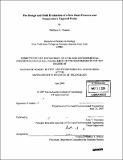The design and field evaluation of a new dual pressure and temperature tapered probe
Author(s)
Chartier, Matthew G. (Matthew Garth)
DownloadFull printable version (9.917Mb)
Other Contributors
Massachusetts Institute of Technology. Dept. of Civil and Environmental Engineering.
Advisor
John T. Germaine.
Terms of use
Metadata
Show full item recordAbstract
The T2P is a new penetration device that measures temperature at its tip and pore pressure at a point just above the tip and at a second location near the base of the probe shaft. The main purpose of the T2P, recently designed and fabricated at MIT, is to reduce the time required to accurately estimate in-situ pore pressures (u₀) of marine sediments. This goal will be accomplished by using the two-point matching method (Whittle et al., 1997; 2001) to compare measured partial T2P dissipation records with theoretical dissipation curves, derived using the Strain Path Method (Baligh, 1985) and total or effective stress soil models. A four-day field program was conducted at a test site in Newbury, Massachusetts to evaluate the design and performance of the T2P. The field program was designed with the intention of performing a number of dissipation tests at a series of elevations within a deep deposit of Boston Blue Clay. Twenty-four hour operation of the data acquisition system allowed overnight dissipation data to be collected. Two boreholes were used to collect a total of eight pore pressure dissipation records, whose length ranged from 0.74 to 19.74 hours. It is not clear if any of the eight monitoring periods were of sufficient duration for full dissipation to occur; it is suspected that measurement periods longer than 20 hours are required to allow complete dissipation around the probe, which is in agreement with previous research (Varney, 1998). The field test data was used to estimate u at various locations within the clay, using the inverse time extrapolation method and the two-point matching method. (cont.) It was found that inverse time extrapolation could be used to approximate u₀ within 10% accuracy from T2P tip data within an average monitoring time of 942 seconds; however, the two-point matching method consistently produced more accurate estimates of u than inverse time extrapolation at similar dissipation times. In addition, soil hydraulic conductivity (k) was interpreted by comparing the measured dissipation data with theoretical curves, using the T50 matching method. The calculated values of k closely matched values previously obtained through laboratory measurements. The T2P field test data is compared with piezoprobe and piezocone penetration and dissipation records, collected at a site in Saugus, Massachusetts (Varney, 1998). Recent modifications have been made to the T2P prototype since the 2004 field test, in preparation for an upcoming sea deployment. These modifications were based upon the field performance of the T2P prototype and design changes required for offshore operations.
Description
Thesis (S.M.)--Massachusetts Institute of Technology, Dept. of Civil and Environmental Engineering, 2005. Page 406 blank. Includes bibliographical references (p. 357-358).
Date issued
2005Department
Massachusetts Institute of Technology. Department of Civil and Environmental EngineeringPublisher
Massachusetts Institute of Technology
Keywords
Civil and Environmental Engineering.